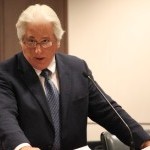Pasadena ‘Walk-Up’ Window Cuts Wait Times
Chief Justice Still Pushing For Court Funds
Great New Courthouse Threatened By Budget Woes
South Asian PAC Alleges Racism In L.A. Judge’s Elections
L.A. Supervisors Face Juvenile Justice Issue
Some Teens Get A Special Court
Civil Court Delays Lead To ‘Private’ Divorce Judges
Plaintiff, Defense Attorneys Agree On Court Funding Need
The Civil Justice Association of California, or CJAC, is among the state’s “tort reform” pro-business groups favoring the proposal. The group’s website cites CJAC President Kim Stone saying that “… businesses in California need a fully functioning, appropriately funded judicial system. Court delays can turn a one year case into a three-year case, with greatly increased costs for both sides. CJAC applauds the $100M increase in judicial branch funding in the 2014 Governor’s proposed budget, but believes that the courts need and deserve more.”
Presiding Juvenile Court Judge who blasted system is calling it quits
Los Angeles is losing one of its more respected judges. And while Superior Court Judge Michael Nash, presiding judge of the county’s sprawling juvenile court system, is doing the old “new opportunities” dance, a column from the L.A. Times might offer insight into his frustrations amid budget cuts and after 29 years on the court.
The judge told the Metropolitan News that he has not decided if he will retire soon or serve out his term, which tuns through 2014. The MetNews also reported that Deputy District Attorney Dayan Mathai Thursday became the first candidate to take out papers to run for Nash’s seat. You can find that story (and if you’re interested in court election news, go ahead and bookmark it) here.

